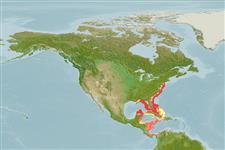>
Ophidiiformes (Cusk eels) >
Ophidiidae (Cusk-eels) > Ophidiinae
Etymology: Lepophidium: Latin, lepus, leporis = rabbit + Greek, ophis = serpent (Ref. 45335).
More on author: Gill.
Environment: milieu / climate zone / depth range / distribution range
Ökologie
seewasser demersal; tiefenbereich 29 - 399 m (Ref. 91765), usually 60 - 399 m (Ref. 91765). Tropical; 46°N - 21°S, 90°W - 73°W (Ref. 91765)
Western Atlantic: Georges Bank, Canada to the Florida Keys and the northern and eastern Gulf of Mexico.
Size / Gewicht / Alter
Maturity: Lm ? range ? - ? cm
Max length : 28.0 cm TL Männchen/unbestimmt; (Ref. 49746); common length : 22.0 cm TL Männchen/unbestimmt; (Ref. 5217)
Kurzbeschreibung
Morphologie | Morphometrie
Rückenflossenstacheln (insgesamt): 0; Rückenflossenweichstrahlen (insgesamt): 129-142; Afterflossenstacheln 0; Afterflossenweichstrahlen: 109 - 121; Wirbelzahl: 73 - 78. This species possess the following characters: usually with 15 precaudal, 58-59 caudal, and 74-76 total vertebral counts; number of fin rays usually in dorsal 131-137, anal 112-117, pectoral 21-23; pyloric caeca 3 (2-4) in tiers of 2-3 caeca in the first and one in the second; total gill rakers on first arch 9-11 (8-13). Colour of head and body tan to brown, belly whitish; a conspicuous and diagnostic series of 14-23 pale spots, which are slightly smaller than the eye but larger than the pupil, extending from just behind the opercle to the caudal-fin base; a second series of smaller pale spots running along the anterior part of the body just below the dorsal-fin base (spots largely disappear in old museum specimens); dorsal and anal fins dark-edged posteriorly; gill chamber, gill bars, esophagus and the roof of the mouth behind the vomer and between the palatines blackish; stomach and hindgut unpigmented (Ref. 91765).
Uncommon species (Ref. 34024). Oviparous, with oval pelagic eggs floating in a gelatinous mass (Ref. 205).
Life cycle and mating behavior
Geschlechtsreife | Fortpflanzung | Ablaichen | Eier | Fecundity | Larven
Robins, C.R., R.H. Robins and M.E. Brown, 2012. A revision of Lepophidium (Teleoastei, Ophidiidae), with descriptions of eight new species. Bulletin of the Florida Museum of Natural History 52(1):1-94. (Ref. 91765)
IUCN Rote Liste Status (Ref. 130435)
Bedrohung für Menschen
Harmless
Nutzung durch Menschen
Mehr Information
NamenSynonymeMetabolismusRäuberÖkotoxikologieFortpflanzungGeschlechtsreifeAblaichenSpawning aggregationFecundityEierEientwicklung
Alter/GrößeWachstumLänge-GewichtLänge-LängeLängenhäufigkeitenMorphometrieMorphologieLarvenLarven Pop.Dyn.RekrutierungDichteBRUVS
ReferenzenAquakulturAquakultur ProfilZuchtlinienGenetikElectrophoresesVererbbarkeitKrankheitenVerarbeitungNutrientsMass conversion
Tools
Zusatzinformationen
Download XML
Internet Quellen
Estimates based on models
Preferred temperature (Ref.
123201): 11.8 - 26.5, mean 19 °C (based on 119 cells).
Phylogenetic diversity index (Ref.
82804): PD
50 = 0.5000 [Uniqueness, from 0.5 = low to 2.0 = high].
Bayesian length-weight: a=0.00174 (0.00096 - 0.00315), b=3.14 (2.98 - 3.30), in cm total length, based on LWR estimates for this species & Genus-body shape (Ref.
93245).
Trophic level (Ref.
69278): 3.5 ±0.1 se; based on diet studies.
Widerstandsfähigkeit (Ref.
120179): hoch, Verdopplung der Population dauert weniger als 15 Monate. (Preliminary K or Fecundity.).
Fishing Vulnerability (Ref.
59153): Low vulnerability (18 of 100).
